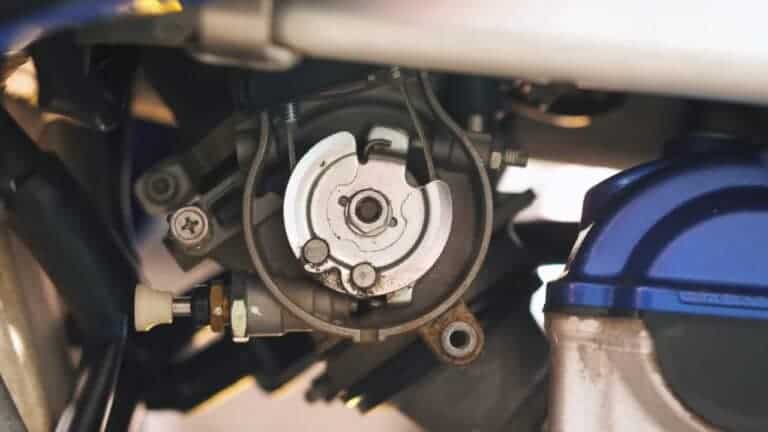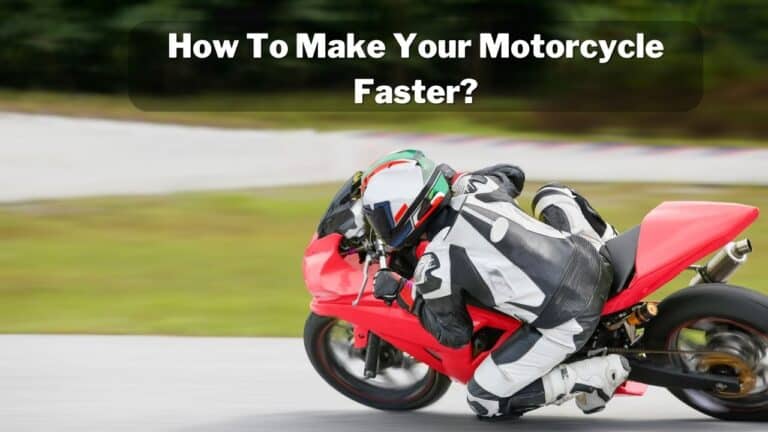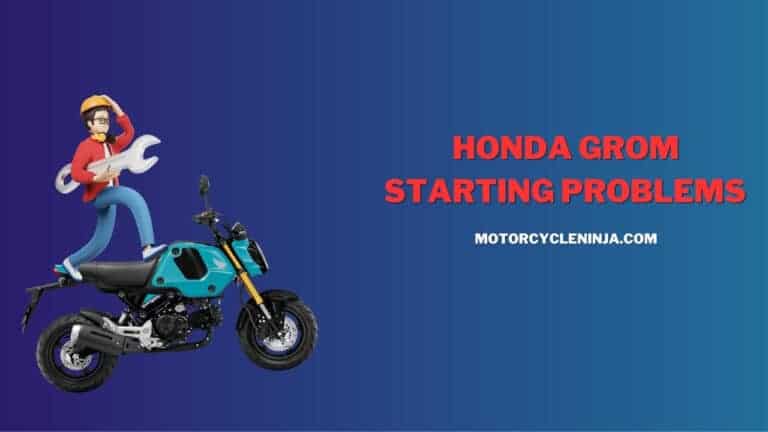Why Is My Motorcycle ABS Light Stays On? -(5 Easy Fixes!)
This guide will demonstrate the common problems associated with Anti-lock Braking Systems (ABS). I’ll also explain why your motorcycle ABS light stays on and how you can fix them.
If you own a superbike, it must have Anti-lock Braking System, aka ABS. It prevents your wheel from locking when you apply the brake and minimizes the risk of wheel skating at high speed and on slippery roads.
An electronic circuit controls the ABS, and an ABS light is given on the instrument cluster showing the status.
A rider told me that his motorcycle ABS light stayed on and asked me to write a detailed explanation.
So, here’s the guide that explains why a motorcycle ABS light stays on while riding and what you should do if your ABS light is glowing.
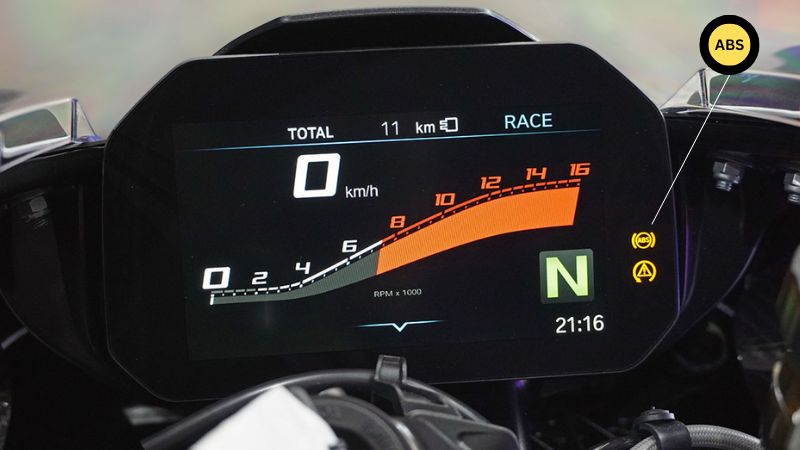
Table of Contents
What Is ABS?
The short answer is- ABS is a Life Saver device! Yes, it saves many life every day on the highway.
Now, let’s look at the technical answer- an Anti-lock braking system (ABS) is an electronic device that prevents the locking of wheels when you apply the brakes. Wheel locking is the biggest reason for road accidents on non-ABS vehicles.
In standard braking (without ABS), when you apply the brake at high speed, the pads bind the disc tightly and lock the wheel instantaneously, and due to wheel locking, the rider loses all control of the vehicle.
But, the vehicle’s weight and motion generate momentum (Newton’s Law) and skids the vehicle, which can cause fatal road accidents.
It also reduces the braking distance and avoids uneven tire wear.
Also Read: How To Fix Squeaking Motorcycle Brake
How Does ABS Work?
Now you know the importance of an Anti-lock Braking System. Let’s see how ABS work on any vehicle.
The ABS module contains four important parts: speed sensors, valves, pumps, and ECU (electronic control units).
With ABS, when you apply brakes, the speed sensors track the decreasing speed of the vehicle and send this data to ECU.
When brakes are about to stop the wheel rotation, your ECU partially releases the brake pads with the help of valves and pumps.
So, your motorcycle or car wheels won’t lock up and continue the motion and stops slowly. Due to this, you won’t lose control of the vehicle.
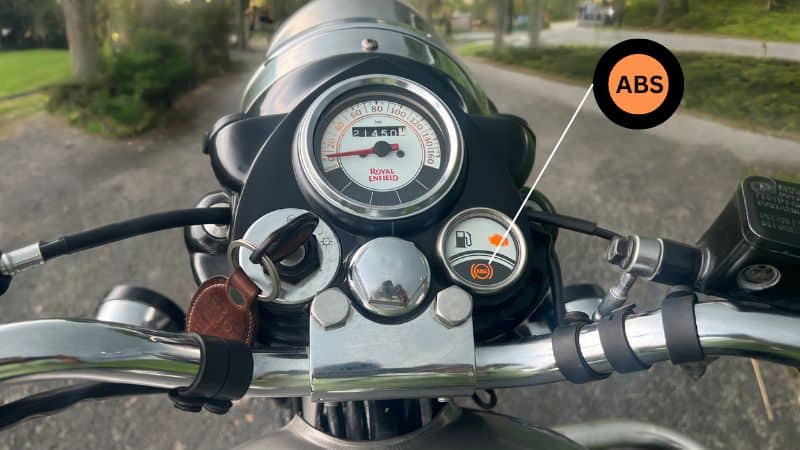
What Causes The ABS Light To Stay On?
When you turn on the ignition key, seeing an ABS light glowing is normal. The ABS light automatically goes off when you move the vehicle for some distance.
But your motorcycle ABS light stays on, alarming some faults in the ABS module that needs your attention.
So, what causes the ABS light to stay on while the motorcycle runs? Your ABS light doesn’t go off because the ECU detected faults in receiving data. It could be due to a dirty or loose speed sensor, broken wheel teeth, broken sensor wire, low brake fluid in the reservoir, and incorrect wheel position.
Related: Why Is My Motorcycle Check Engine Light On
How To Solve Motorcycle ABS Light Problems?
Now, you know the common reasons that cause motorcycle ABS light to stay on. It’s time to rectify the culprit and fix that.
If your motorcycle (or car) ABS light doesn’t go off while riding, here are five easy methods to fix the problem-
1. Tighten Speed Sensor Screw
As of now, you know how an ABS works. A speed sensor (installed on the wheel) reads the motorcycle’s speed and sends the data to ECU.
The ECU controls the brake pads when you apply brakes at high speed, preventing the wheel from locking.
Over time, vibrations loosen the speed sensor screw, creating problems in reading the wheel’s rotation and not sending signals to the ECU. Due to the absence of signals, your ECU triggers the ABS light.
To fix this, inspect the speed sensor screw and tighten it fully with a screwdriver or Allen key. If the problem continues, move on to the next troubleshooting.
2. Clean Speed Sensor

The speed sensor uses the magnetic field to reads the wheel speed. Sometimes, metal chips, dirt or debris, or oil on the sensor disturbs the proper functioning of the speed sensor.
You must remove the speed sensor from the wheel and clean it with a microfiber cloth. After cleaning, install the sensor and ride the motorcycle a few meters to see whether the ABS light goes off.
Mostly, cleaning the speed sensor will fix the ABS light problem. If it doesn’t resolves, move on to our next troubleshooting.
3. Inspect Sensor Wire
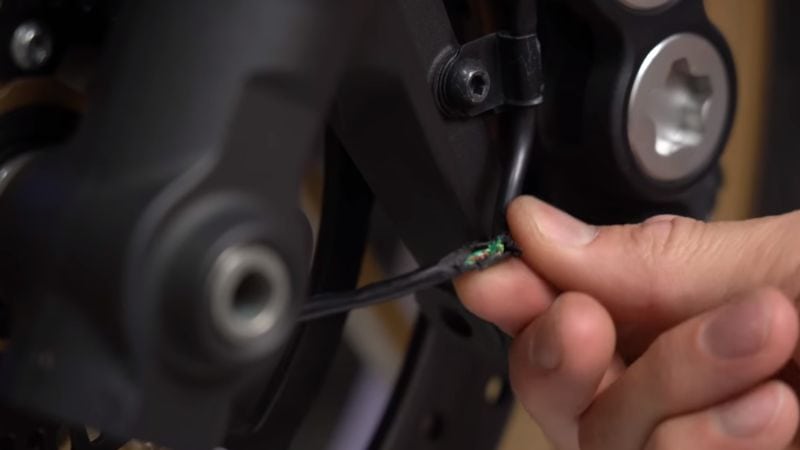
The speed sensor receives power from the battery and sends signals to ECU via wires. If the sensor wire breaks, your ABS will not work.
Inspect the speed sensor wire and replace it if broken. You can buy a motorcycle speed sensor from Amazon or visit the nearest mechanic garage.
Click here to buy a speed sensor on Amazon
4. Clean Tooth Wheel
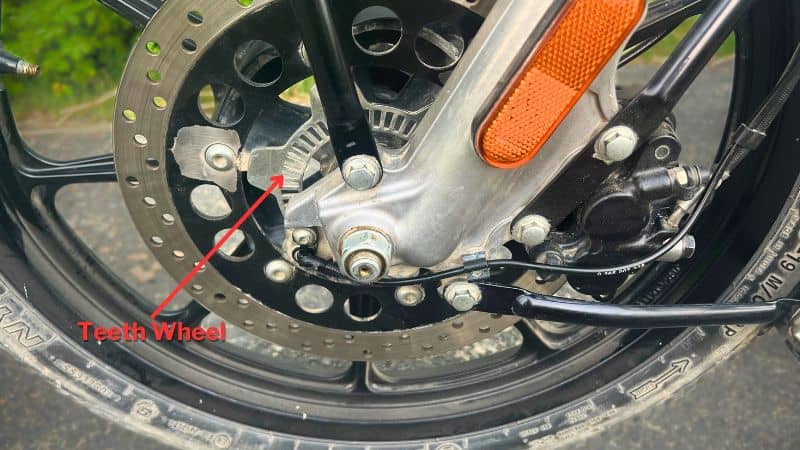
If you look near the brake caliper assembly, you’ll see a wheel attached to the brake disk, and it has teeth.
This wheel helps speed sensors to sense the actual speed of the motorcycle. If any teeth are blocked with mud, grease, or debris, the sensor will face difficulty sensing the motorcycle’s speed.
So, carefully check the ABS sensor wheel and clean it if anything is blocking the teeth. If any teeth are broken, you must replace the wheel.
I advise you to visit the nearest mechanic garage and buy OEM parts because your ECU is programmed accordingly.
5. Change Brake Fluid
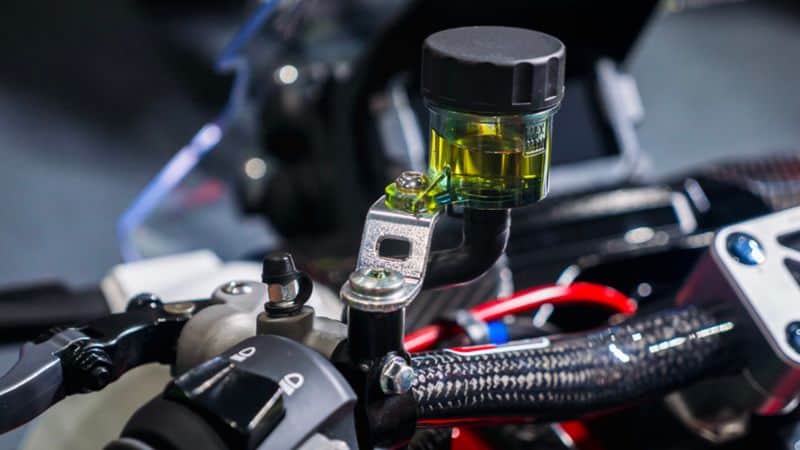
As I told you above, a low brake fluid level in the reservoir affects the operation of the ABS valves and pumps.
You must change the brake fluid yearly for smoother braking action. Always maintain the correct brake fluid level in the reservoir because a low fluid level will make your brake spongy, and a high level will make your brake lever hard to pull.
Click here to read my detailed guide on when to change brake oil on a motorcycle.
The minimum and maximum level is already marked in the reservoir. So, check that by opening the reservoir.
If you follow these methods correctly, the ABS light is always on the issue will be resolved. If the problem persists, you need to clear the ECU codes.
You need an OBD2 scanner that supports motorcycles to clear ECU code history.
Click here to buy a scan tool on Amazon.
Is It OK To Ride With ABS Light On?
The braking system still works even if the ABS module stops working, and you can continue riding your motorcycle or car with the ABS light on. However, it increases the risk of wheel locking in heavy braking conditions.
If the ABS indicator light constantly glows, your motorcycle or car braking system will work like a non-ABS vehicle.
So, I don’t recommend high-speed highway rides with ABS lights stays on because it increases the risk of fatal accidents.
You can drive your car or motorcycle to the nearest mechanic shop to fix the ABS module problem with a professional.
Is ABS Warning Light Serious?
If you ride at high speed, the ABS warning light is serious because applying brakes at high speed increases the risk of wheel locking, which could result in accidents.
However, you can continue riding your bike or car with an ABS warning light at a slow speed. You can press-release-press the brake paddle in an instant braking situation to prevent wheel locking.
What Happens If You Ride With Faulty ABS?
Your brakes will normally work with faulty ABS, but it increases the risk of “wheel lock” in heavy braking situations.
The wheel lock is a major cause of road accidents worldwide. Riders lose control of the vehicle in instant braking conditions and skids.
I don’t advise you to ride a motorcycle with a faulty ABS. Follow the above methods to rectify the issue and fix it yourself.
Conclusion
A dirty speed sensor and broken wire connections are the major cause of ABS lights on motorcycles. In 80% of cases, cleaning speed sensors and tooth wheels fix the ABS problems.
I don’t advise you to ride your motorcycle with a faulty ABS because it increases the risk of wheel locking. Follow the above methods to fix it yourself.
Have a safe ride! Cheers!

